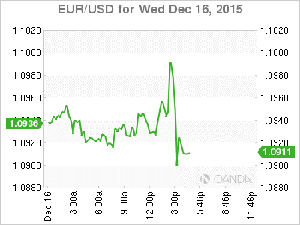Given the US Fed’s decision to raise rates (as expected) on Wednesday, OANDA senior currency strategist Alfonso Esparza explains that—though he feels the rhetoric from the Fed statement remains accommodative—he thinks its data dependent guidance may continue to bring uncertainty and volatility in 2016.
The US Federal Reserve raised rates for the first time after nine and a half years. The interest rate rise by 25 basis points is a validation of the US economic recovery after the crisis of 2008. The hike had been highly anticipated and its final arrival did not cause the USD to appreciate beyond current levels.
There was a lot of anxiety from investors ahead of the central bank rate announcement after the European Central Bank (ECB) had failed to communicate its intentions to the market. The Fed delivered as promised and little more. The market’s expectations were met, but not exceeded, giving no boost to the USD. The transitory factors affecting the economy have taken longer than expected to work themselves out and have, in fact, forced the Fed to adopt a more gradual pace of rate hikes in 2016.
The rhetoric from the Fed statement remains accommodative, but its data dependent guidance will continue to bring uncertainty and volatility in 2016.
Rate Statement
The language from the December Federal Open Market Committee (FOMC) rate statement saw plenty of changes besides the federal funds rate target increase to ½%. The market had already priced in the first rate hike in nine and a half years so the focus was going to be on the additional language and the insights into Fed actions in 2016.
The statement emphasized on multiple occasions the employment recovery and labeled the reduction of slack as “appreciably.” Wage growth concerns remain as there is very little inflationary pressure.
The Fed added the line after its dual mandate:
- The Committee expects that economic conditions will evolve in a manner that will warrant only gradual increases in the federal funds rate; the federal funds rate is likely to remain, for some time, below levels that are expected to prevail in the longer run.
Data dependency will remain, but the use of the word gradual hints at a slower pace that initially communicated via the economic projections.
Economic Projections
Fed officials forecast a median of 1.375% in 2016. This marks a lower target hinting at a slower pace of rate hikes. Given that 2016 is an elections year, the Fed will refrain from monetary action close to the elections, which leaves three to four rates hikes in the year…or less if the US economy recovery hits a snag.
Fed officials are not optimistic about a return to 2%, until 2018. The inflation expectations in the new projections is 1.6%, compared to 1.7% in September.
Press Conference
Fed Chair Janet Yellen got a chance to explain the decision by the members of the FOMC to raise rates in her reading of prepared remarks followed by a round of questions from the financial press. Chair Yellen pushed forward the idea that the US provides strength to the global economy. Employment has recovered, but weakness remains, in particular, wage growth is lower due to lack of inflationary pressure. Yellen asked market participants to move beyond this first rate hike, as the central bank will remain vigilant and depend on data for the basis of its monetary policy decisions. Yellen made sure to communicate that “gradual” does not mean mechanical when talking about future interest rate hikes.
By Alfonso Esparza,Senior Currency Strategist, OANDA






















